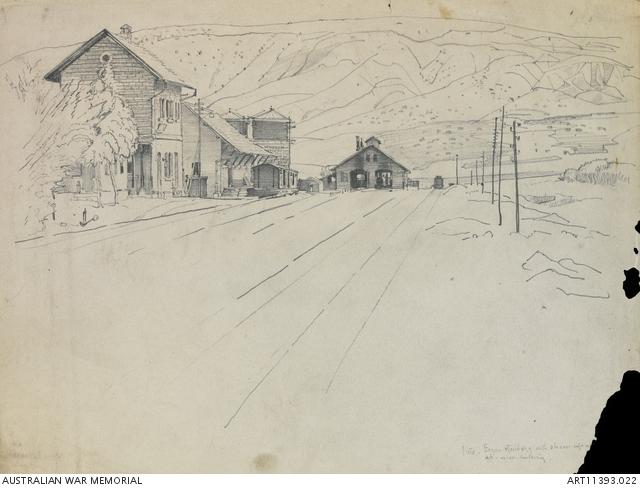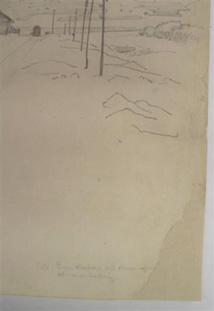Recovering from loss
When Gajendra Rawat and I (Sophie) surveyed the Lambert artworks on paper for the exhibition we identified a couple of works that required some repairs prior to being displayed.

Engine Standing with steam up at stop - main building, Train station, Semakh.
This drawing Train station, Semakh by George Lambert (left) had areas of loss due to an insect attack (which happened before we purchased the drawing in 1930). Lambert described Semakh as "a railway station of picturesque conglomeration of not more than usually dirty Arab huts, and a few tents and horses of the occupation people on the shore, southern end, of the Sea of Galilee. It is really beautiful here." 1 The drawing was made in June 1919 as Lambert toured Palestine after his visit to Gallipoli with the Australian Historical Mission.
We decided to infill these losses with western style papers. Western papers are made from short fibres such as cotton linter or wood pulp. The paper was chosen based on its weight and texture being similar to Lambert's. It is a medium weight western paper with no papermaking marks (chain or laid lines). As the paper was not the right colour it was toned with high quality watercolour paints. The shape of the loss area was traced to enable the most accurate reproduction of the paper shape required.

The western paper used for the repair was adhered to the drawing with dilute wheat starch paste with a Japanese tissue repair strip on the back for support. Japanese tissue paper is made from long 'bast' or plant fibres like Kozo, Mitsumata, or Gampi, which are all light and strong. We are guided by conservation ethics so we only use materials of the highest quality and most stable nature, for example starch paste and Japanese tissue, and the repairs must be completely reversible to allow for removal if it is necessary in the future. Once repaired the drawing was left under weights for a couple of days to make sure it was nice and flat. As you can see in the picture below, the end result was that the loss was disguised yet the modern repairs are still visible to the trained eye.
1. Amy Lambert Thirty Years of an Artist's Life, Sydney 1938, p. 125.
Sophie Lewincamp, Conservator-Paper